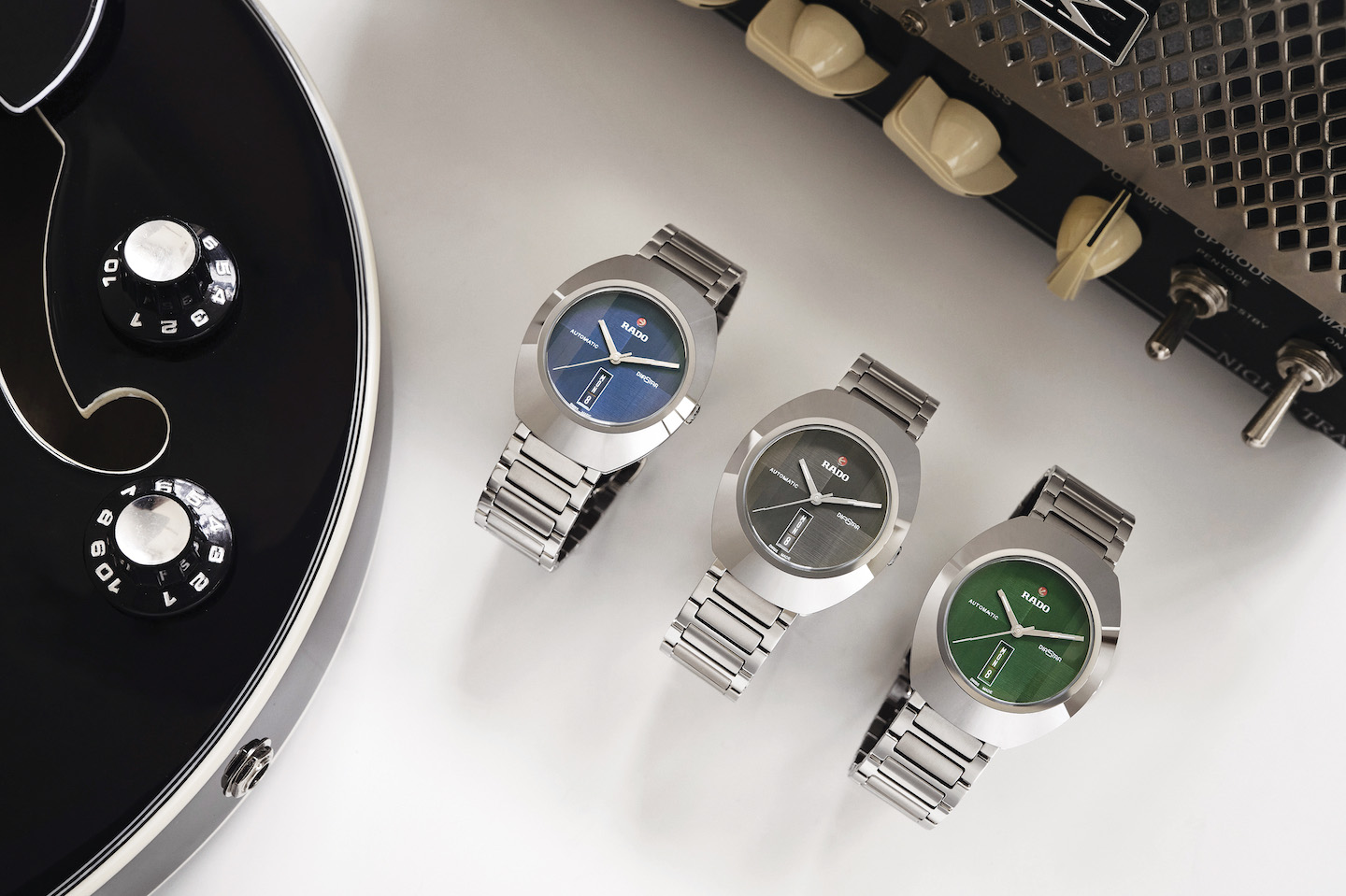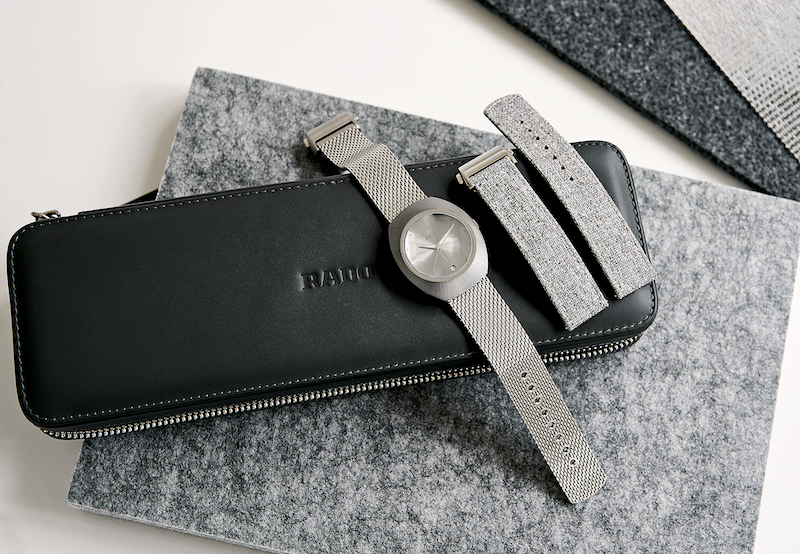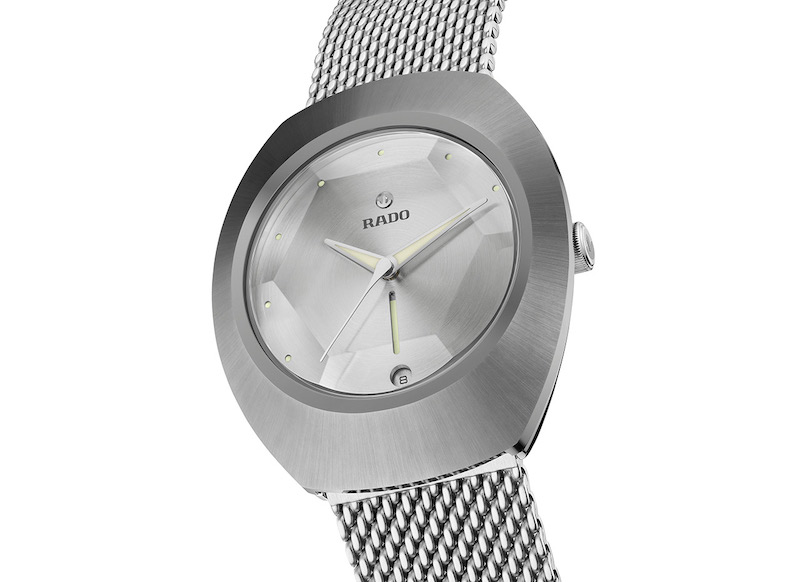
Rado’s DiaStar Original models are endowed with grey, blue and green dials and characterised by a bi-directional brushed finish (All photos: Rado)
The 1960s was a time of intense creativity and joy — and for good reason. The world was riding the wave of the post-war boom, and it was a carefree time of innovation, peace, fashion and great music underwritten by the idea of a better life for everyone. Although the 1960s was a sensational period that mostly affected the US and the UK, the Swiss watchmaking industry was just as inspired by the zeitgeist, especially Lengnau-based manufacture Rado, which was then still known as Schlup & Co. As momentum picked up for all industries to innovate and thrive, watchmaking included, the company wanted to stake its claim with a timepiece that would truly stand the test of time, and it saw the Sixties as the ideal time to launch a watchmaking icon.
With that ideal firmly in mind, Rado’s engineers and designers turned their attention to the materials that were going to be used for the case and watch crystal. The projected timepiece would have to be both an outstanding example of durability and good looks, of course, but also capable of keeping those qualities nearly forever. The plan was to make the watch case and bracelet with a tungsten carbide alloy called hardmetal, and in that shiny, scratch-resistant case, a sapphire crystal glass almost as hard as a diamond. This was a forward-thinking move at the time, as most watches then were made of gold or plated brass with a glass of mineral or polymer origins, rendering them fairly susceptible to damage.
In November 1961, Rado patented the use of hardmetal in watchmaking and became the first to combine this material with sapphire crystal in a watch case. At the Baselworld Watch and Jewellery show the following year, the brand unveiled the DiaStar: a truly one-of-a-kind watch that represented the most advanced technology available at the time in material research that eventually became the maison’s most enduring icon.
dsc07485_final_a5.jpg

It was during the DiaStar’s 60th anniversary celebration in Zurich last month that we managed to glean a few more details about this unusual watch — most critically, that it was sort of an accident. In preparation to visit Comadur, the state-of-the-art factory where all Rado’s ceramic components are made, some sleuthing uncovered that the DiaStar’s shape arose from technical constraints rather than a particular aesthetic objective. As modern as Comadur’s facilities are today, machining such a hard alloy back then relied on far less sophisticated equipment. The DiaStar had landed its signature oval shape by chance, but a few shrewd key decision-makers within Rado opted to stick to it — and history was born. Sixty years later, with nearly five million watches sold around the world, everyone at Rado can look back on that decision with pride, even if the early years were a soft crescendo rather than a spike to instant fame as the DiaStar’s design is polarising, even today. But once you are a fan, it is for life.
Some of Rado’s earlier marketing strategies were the gimmicky sort of stuff no one would even consider for a watch in this day and age. During product demonstrations, people were invited to try and damage the DiaStar’s shiny finish with all manner of sharp objects, but to no avail. No one could believe an alloy so impervious to abuse could exist, and that reputation was what everyone couldn’t stop talking about.
The various DiaStar models through the years have used this special hardmetal alloy, a blend of ceramic with a metal binding agent that is injection moulded, sintered under vacuum and then mechanically finished using diamond tools. Other processes have come into play at different times, such as the DiaStar Original’s titanium-nitride CVD (chemical vapour deposition) treatment, to give the model its distinct gold colour while retaining a tremendous surface hardness that soft and delicate gold could not have provided.
Faithfully at work in their creative and fiery universe, Rado’s engineers continued to spearhead their research, introducing new materials, such as high-tech ceramic, plasma high-tech ceramic and their very own Ceramos, into specific product lines. Lighter than the tungsten carbide-based hardmetal, Ceramos brings the new lightness of titanium carbide to the exceptional characteristics of high-tech ceramic, while also adding the possibility of creating colours with a metallic sheen, in shades of steel, rose gold or yellow gold.
New journey for DiaStar
In celebrating the DiaStar’s 60th anniversary, the team at Rado approached the watch with a two-pronged strategy: honour its iconic design, but also, innovate for the future. Within the stunning setting of the Landesmuseum Zürich, Rado unveiled an anniversary collection that paid homage to its legacy in design, wearability and technical innovation.
Created in collaboration with Swiss designer Alfredo Häberli, the DiaStar Original 60-Year Anniversary Edition comes in a matte-finished Ceramos case measuring 38mm by 12.3mm that frames a grey dial protected by a sapphire crystal with hexagonal facets — six to mark each of the watch’s six decades of existence. The hands and hour markers are coloured with a touch of Super-LumiNova. Within the case, Rado’s Calibre R764 automatic movement beats at a frequency of 4Hz (28,800 vibrations per hour) and offers 80 hours of power reserve. The watch comes with two straps: a stainless-steel mesh “Milanese” bracelet, as well as a mottled grey textile strap: Rado’s EasyClip system makes the change between the two quick and easy.
portrait_a.haeberli_4.jpg

“In my work as a designer, I’m always trying to combine tradition and innovation with joy and energy, and the anniversary edition is no exception. In essence, the point was to take the features of the original DiaStar and give them a contemporary form,” Häberli says. “There’s been a minor geometric adaptation of the case to make it look more elegant and lighter. The faceted cut of the watch glass was reinterpreted in a hexagonal form meant to highlight the 60th anniversary. The hands and date display were designed to look as modern and abstract as possible.”
Of Argentinean heritage but Swiss upbringing, Häberli is known to bring to his creations a blend of emotion and practicality, of evocative form but always, functional design.
“With every product I try to add value, which lies in the everyday usefulness of the design. For the DiaStar that means you have to be able to wear it on different occasions, so it comes with two alternative straps and in a leather case that can be used as protection while travelling.”
A watch collector since he received one from his father at 18, Häberli was given free rein for his assignment with the DiaStar. The owner of a Rado timepiece for many years now, he was familiar with the brand and impressed with its innovative spirit in terms of material research — a quality that resonated with his own practice. As a result, his design process didn’t take very long at all.
rado_new.jpeg

“When I suggested to Rado that we give the anniversary edition a radically modern design, I grasped the opportunity and worked up the new case inside of two weeks,” he says. “This trust and the exceptionally constructive collaboration with the project manager and engineers made it possible to ‘revolutionise’ — the word is perfectly accurate — the model in under a year. It also helped, of course, that I am so passionate about watches. It took only one year to develop this timepiece, but I’ve been engaging with watches for the last 40 years. There is precision in the automatic movement, in the material, in the workmanship and geometry, and the poetry lies in the fascinating, ineffable matter of time.”
Häberli has applied a distinctly Art Deco aesthetic sensibility to the DiaStar Original 60 Year Anniversary Edition, but it is admittedly not for everyone. Admiring it on the wrist, it occurred to many of us attending the launch that an everyday version that would be a worthy torchbearer for the range’s highly recognisable design is a deserving addition to the anniversary collection.
Rado was one step ahead of us on this with the DiaStar Original models, endowed with grey, blue and green dials, and characterised by a bi-directional brushed finish. Within a polished ceramic and stainless-steel case held together by a matching bracelet, the same Calibre R764 tells perfect time. However, while the anniversary model boasts a date and graphical day display at 6 o’clock, the Original model makes things easier on the eyes with a larger and more easily read day/date display in the same location.
The manufacture behind the magic
Basking in the joy of the successful launch of the new DiaStar watches, the Rado team took the opportunity to organise a visit to Comadur, the factory in Le Locle where all the brand’s high-tech materials are made. Now owned by the Swatch Group, Comadur is a leading ceramics specialist that also supplies parts to other brands within the group — Breguet, Blancpain and Omega, for example — although the bulk of what they do is for Rado.
The important thing to keep in mind when it comes to ceramic watches is how hard they are to make — they require far more complex processes than materials like gold, steel, bronze and even titanium. A steel case can be stamped, machined and finished in a day, maybe a few more if done entirely by hand. But a ceramic component, regardless of its size and function, takes a full two weeks to produce.
The upside to this is its durability — it is scratch-proof, extremely strong and gleams in the very same way no matter its age. In fact, Rado’s manufacture in Lengnau boasts a collection of vintage watches that simply do not show their age at all owing to the nature of the ceramic used in the design. As Rado’s engineers have continued to push the boundaries of material science and innovate within this niche space, even more advances have been made in ceramics manufacturing — and it all happens on-site in Comadur.
rado_comadur_captaincook_frittage_001.jpg

Though related in some respects to more common forms of ceramics we all know, high-tech ceramic is truly a product of advanced science. Under highly exacting conditions, extremely pure and finely calibrated powders of aluminium oxide, zirconium oxide and silicon nitride with perfectly uniform grain sizes are shaped into a particular form, then baked at high temperature to create an object or a watch case of the desired dimensions and properties. New methods developed by Rado involve the use of a plastic carrier medium mixed with the mineral powders, to allow injection into precision moulds at pressures around 1,000 bar.
Once cooled, the pieces are removed from their parent mould and the carrier agent dissolved in a standard chemical solvent process, prior to a final sintering phase at 1,450°C. The procedure is true rocket-science territory, as the dimensions of the first moulded elements shrink during sintering; the particles tighten up as porosity disappears and precise calculations must take into account this important change of around 23% in the dimensions. The reward is a case that now stands at 1,250 on the Vickers scale — by contrast, stainless steel is merely 152 Vickers — and is ready for final diamond-tool machining and finishing.
As the only thing able to affect high-tech ceramic is high-tech ceramic itself or anything harder than that, each component is placed in a vat with kernels of the same material. The vat vibrates and polishes the surface of the components. This can take up to a week depending on the intended result, multiple steps calling for gradually smaller ceramic polishing kernels.
rado_comadur_captaincook_plasma_008.jpg

While high-tech ceramic parts are for general use for many watch maisons, Comadur’s manufacturing of plasma high-tech ceramic is exclusively for Rado. The process starts out with white polished ceramic components placed in a special reactor and fired up to 20,000°C. For some perspective: the earth’s core is estimated to be around 5,200°C and even the surface of the sun peaks at a toasty 5,600°C. Although during our visit we didn’t see any components being fired at this temperature, if we did, it would certainly have felt a little like witnessing the birth of a star.
Comadur doesn’t receive too many visitors as few people outside watchmaking are aware of such a facility, or the depths of knowledge and innovation contained in its hallways. Rado is a major beneficiary of this know-how, and it certainly makes the best of it with each watch it creates.
This article first appeared on Nov 14, 2022 in The Edge Malaysia.


